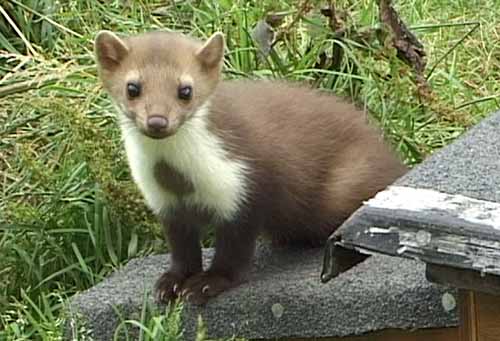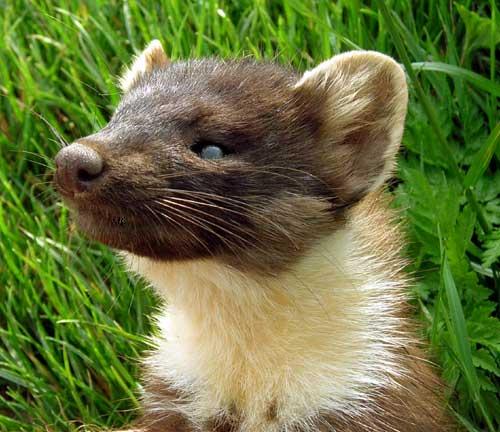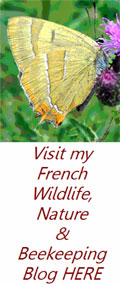Stone Marten and Pine Marten France

There are many similarities shared by these two extremely close species both in their visual characteristics and their overall behaviour, an attempt has been made to draw attention to the major differences
The Stone Marten, sometimes known as Beech Marten, is widespread in most regions of France where there is adequate cover, buildings, trees or dense scrub. They can grow to 50 centimetres with about half as much again for the tail, their fur can be various shades of brown, usually dark or chocolate, possibly with a greyish tinge, white patch under the chin and top of the chest which divides in two running down each front leg, the size of this is variable.

Omnivorous and opportunistic in diet depending on the time of year, taking whatever is readily available. In summer and autumn they are predominately vegetarian eating berries, fruits, insects, small mammals and nuts. In winter and spring they tend to catch more live prey, small mammals, birds, young rabbits and hares, birds eggs and even earth worms will be eaten. Extra food is often taken when available and put in a “larder”, this is normally small mammals.
Considered to be nocturnal they will usually go out and come back to their current “home” several times each night, they are rarely observed during daylight hours. An individual Stone marten can have a home range of up to 80 hectares but this is extremely variable and usually only one or two habitual “homes” are used in a territory. They are very agile, excellent climbers but generally more terrestrial than Pine Marten.
Home for a Stone marten can be in a hollow tree, a fissure in a rock face or quarry, a pile of rocks, an underground tunnel or cave and most importantly for humans in a roof space, barn or other building where they often cause concern for the human occupants.
Breeding takes place in summer with a delay of some 250 days before implantation and pregnancy starting, the gestation has a duration of 30 to 50 days, this delay between copulation and the start of pregnancy allows the young to be born the following spring, when the mother gives birth to 3 or 4 young, there are frequent vocal exchanges between the mother and her young which will probably be clearly heard if they are in your roof.. If you should have them in your roof space, a method which is widely recommended to deter them and encourage them to move out is by scattering moth balls (boule de naphthaline) in and around the area they are using.
Excrement will often be found in one or several heaps near to where they are living, the form of this varies greatly with diet. Pine & Stone Marten excrement / droppings HERE
The Pine Marten can also be found in most regions of France, in this case where there are sufficient trees, whether this is in the form of forest or copses, conifer, broadleaf or mixed. Size is similar to that of the Stone marten, as is the colouration but without the greyish tinge, larger more prominent rounded ears and generally a larger bushy tail, the chin and upper breast patch is more cream or yellowish and doesn’t divide in two but forms a solid patch.

Although omnivorous they usually have a different diet regime to the Stone Marten. During the spring and summer field voles, common voles and birds will play a major role as will frogs and beetles. As summer progresses fruits, such as blackberries, and nuts will be consumed in larger quantities and nuts will sometimes be collected and stored. In winter it’s mainly small mammals and any grains or seeds that are available.
Although mainly nocturnal they will venture out during daylight. It’s not unusual to see them at dawn or dusk, and they will also be seen at any other time of day especially during the summer and early autumn months. There is a huge variation in territory, a female may only travel short distances from “home” or may move around in an area up to 15 square kilometres. Males will travel around even more in an area of anything up to 25 square kilometres and will use several different places for sleeping during the day. They are extremely agile, superb climbers and spend a lot of their time in trees where they can leap long distances, often from one tree to another.
Home for the Pine Marten can be almost any type of cavity, in the ground, in a tree or even larger bird nesting boxes, very occasionally a female may use part of a building, usually unoccupied, to give birth to her young, but they tend to keep their distance from humans more than Stone Marten.
Breeding follows more or less the same pattern as Stone Marten.
Excrement is deposited at intervals along the course of their regular routes and is usually prominently placed; females may place some in close proximity to the site they are using to raise their young.
Pine & Stone Marten Excrement / Droppings HERE
Populations are thought to be stable.



